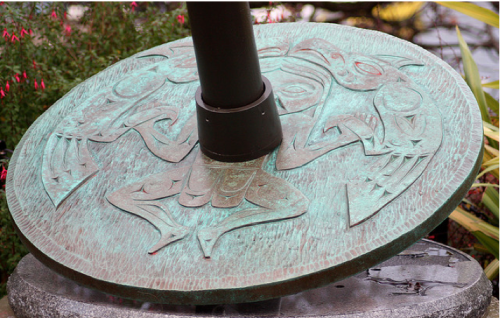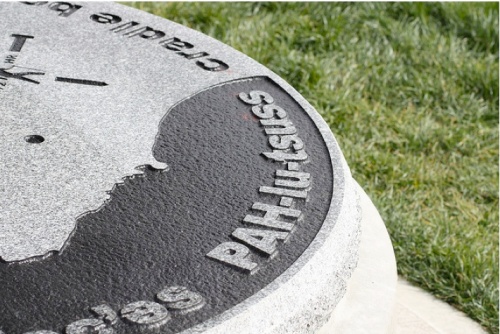
Signs of Lekwungen "Walk in Two Worlds", near corner of Fort and Wharf Street in Victoria. Source: Flickr.com user ngawangchodron
The city of Victoria in collaboration with the Songhees and Esquimalt First Nations has fairly recently created a series of outdoor art installations which mark culturally-significant places. As the City’s online brochure explains,
Established in 2008, the Signs of Lekwungen (pronounced Le-KWUNG-en) is an interpretive walkway along the Inner Harbour and surrounding areas that honours the art, history and culture of the Coast Salish people who have resided in the Victoria area for hundreds of years.
The Songhees and Esquimalt Nations are part of the Coast Salish family and are descendants of the Lekwungen family groups. Lekwungen is the original language of this land.
The Signs of Lekwungen consist of seven unique site markers – bronze castings of original cedar carvings, conceptualized and carved by Coast Salish artist, Butch Dick. The markers depict spindle whorls that were traditionally used by Coast Salish women to spin wool. The spindle whorl was considered the foundation of a Coast Salish family.

Original wooden carving for the casting placed in Beacon Hill Park to commemorate burial cairns. The otters are spirit helpers. Source: Flickr.com user ngawangchodron.
The original wooden sculptures can be viewed at City Hall. The 7 markers are outlined at the city webpage. You can download a PDF brochure here, which has more complete information in some ways than does the web site, and also has a handy map. However, these sources have rather inadequate illustrations, so clicking on the pictures I am using here takes you to a fine set on flickr.com by user “ngawangchodron”.
This project is a welcome addition to urban Victoria, reminding us visually and thematically of the spiritual landscape which still is woven into the modern world. It’s a nice improvement on the apparent situation in Beacon Hill Park, where elsewhere I noted the following:
Acknowledgment of more than 1,000 years of native occupation and use of Beacon Hill Park land is limited to one sentence–sandwiched between information about Roderick Finlayson and a gun emplacement–on a Finlayson Point monument. By contrast, at least thirty-six park monuments, markers and plaques focus on the white culture’s 162 year presence. Nine of those markers honour the British Royal Family.
We can add the above cairn marker to the mix now, which is progress.
This project also reminds me of the recent installation of interpretive roadside kiosks in Squamish and Lil’wat territory, discussed here and here. While the Signs of Lekwungen are not as explicit as those kiosks are, they are arresting and challenging works of art which deviate from much of the Northwest Coast touristic kitsch which dominates lower Government Street. I’d like to see this as a ladder towards more explicit signage along the Squamish-Lil’wat model. Tourists and residents alike are starved for information about the cultural history of the urban environment as well as the less developed parts of the province. It would be great to see more projects which work with First Nations to bring history out into the streets, thereby making strong yet beautiful statements about the abiding cultural landscape at the heart of the Provincial Capital.



Congrats to those involved in making this excellent initiative happen (if only it could be expanded more). Looking at the many groups involved on the brochure makes me think of how much work this took. I think I recall that the some impact assessment archaeology was done before the signs were installed even.
LikeLike
Pingback: Notable Blogs: 9/28/10 « Dreaming the World
This blog reports on an interesting talk I didn’t hear about in time, by John Lutz on the topic of “getting the Indians out of town”, or how Victoria came to be an almost aboriginal-free space. It mentions Signs of Lekwungen, so I am mentioning it here.
http://vincentsvictoria.wordpress.com/2010/10/27/the-city-talks-getting-the-indians-out-of-town-race-and-space-in-victoria%E2%80%99s-history/
LikeLike
There is a similar recently completed sign project in Oak Bay as well.
http://www.bclocalnews.com/vancouver_island_south/oakbaynews/news/105388393.html
LikeLike
What a superbly evocative lecture title. If memory serves me, I think that John Lutz was involved in the initial moments of the ‘signs’ project. It would be neat to know the history. Wish i could’ have gone to the talk too…
LikeLike
In my paper on this topic in the spring, I wrote that “The interpretive panel [for the Sings of Lekwungen sculpture at Songhees] mentions that a reserve formerly occupied the site – but failed to mention the controversies surrounding the move or that there are related land claims elsewhere in Victoria. While it’s positive to celebrate the culture of the Songhees through this public art work, I worry that it also allows us to forget how controversial, contested, contradictory and problematic this issue really is.” This led me to wonder how we can appropriately problematize public history without offending or confusing people who don’t have a great deal of background in these issues. I don’t have any good answers to this question.
LikeLike
Hi Vincent, thanks for your comment. It’s a good point you make, and perhaps my overview was more coloured by the “something is better than nothing” train of thought, in terms of at least a pointing finger at the cultural landscape. On the other hand, I haven’t been to the one at Songhees Point, myself.
I would note that, at the risk of an extremely broad generalization, there could be some sly humour or concealed commentary going on here too. Fior example, it is hard to know what to make of the fact that the city web site says the Sign by city hall is themed as
Seim Speaker (a person held in high esteem who speaks for the people)
Whereas the brochure, which seems more authoritative, or at least longer and more detailed, essentially refers to City Hall as
“Bitter Cherry Tree”
I guess what I am saying is, there may be a deeper, multilayered commentary being expressed through the Signs than the one meant for public consumption, so the notion we need to problematize it might miss the point. That’s pure speculation of course, and right now I do think we need to think about your question, how to problematize history without turning people off of it. It reminds of the role of archaeology in Quebec, where “Amerindian” archaeology is fairly niche, partly, it is said, because the position of Quebecois vis a vis indigenous people mirrors that of the English vis a vis Quebecois. As a result, Quebec has probably the most vibrant historical/urban archaeology in the country. Making people uncomfortable is good, but making them listen is better.
Nonetheless, I enjoyed your essay, and, for those who come to this page directly, I posted about your blog here:
https://qmackie.wordpress.com/2010/10/30/victoria-cartoon-history/
LikeLike
Pingback: Sahsima and Chickawich – Cairns marking Songhees places in Oak Bay « burnt embers
Pingback: Breakwater Mural I « burnt embers